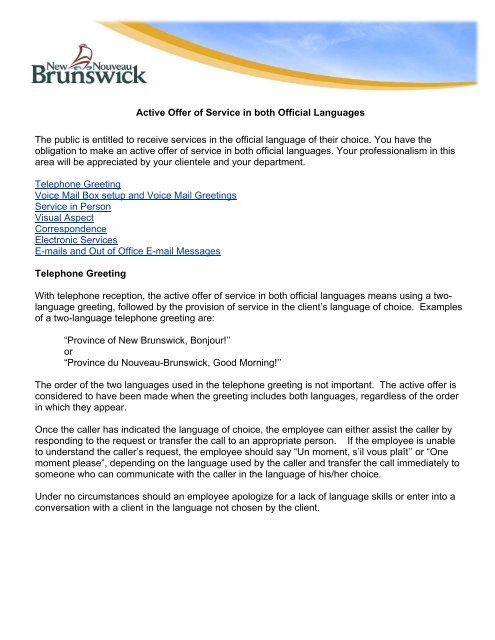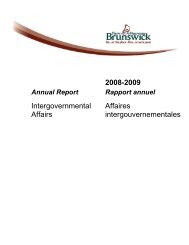Active Offer of Service in both Official Languages - Government of ...
Active Offer of Service in both Official Languages - Government of ...
Active Offer of Service in both Official Languages - Government of ...
You also want an ePaper? Increase the reach of your titles
YUMPU automatically turns print PDFs into web optimized ePapers that Google loves.
<strong>Active</strong> <strong>Offer</strong> <strong>of</strong> <strong>Service</strong> <strong>in</strong> <strong>both</strong> <strong>Official</strong> <strong>Languages</strong><br />
The public is entitled to receive services <strong>in</strong> the <strong>of</strong>ficial language <strong>of</strong> their choice. You have the<br />
obligation to make an active <strong>of</strong>fer <strong>of</strong> service <strong>in</strong> <strong>both</strong> <strong>of</strong>ficial languages. Your pr<strong>of</strong>essionalism <strong>in</strong> this<br />
area will be appreciated by your clientele and your department.<br />
Telephone Greet<strong>in</strong>g<br />
Voice Mail Box setup and Voice Mail Greet<strong>in</strong>gs<br />
<strong>Service</strong> <strong>in</strong> Person<br />
Visual Aspect<br />
Correspondence<br />
Electronic <strong>Service</strong>s<br />
E-mails and Out <strong>of</strong> Office E-mail Messages<br />
Telephone Greet<strong>in</strong>g<br />
With telephone reception, the active <strong>of</strong>fer <strong>of</strong> service <strong>in</strong> <strong>both</strong> <strong>of</strong>ficial languages means us<strong>in</strong>g a twolanguage<br />
greet<strong>in</strong>g, followed by the provision <strong>of</strong> service <strong>in</strong> the client’s language <strong>of</strong> choice. Examples<br />
<strong>of</strong> a two-language telephone greet<strong>in</strong>g are:<br />
“Prov<strong>in</strong>ce <strong>of</strong> New Brunswick, Bonjour!’’<br />
or<br />
“Prov<strong>in</strong>ce du Nouveau-Brunswick, Good Morn<strong>in</strong>g!’’<br />
The order <strong>of</strong> the two languages used <strong>in</strong> the telephone greet<strong>in</strong>g is not important. The active <strong>of</strong>fer is<br />
considered to have been made when the greet<strong>in</strong>g <strong>in</strong>cludes <strong>both</strong> languages, regardless <strong>of</strong> the order<br />
<strong>in</strong> which they appear.<br />
Once the caller has <strong>in</strong>dicated the language <strong>of</strong> choice, the employee can either assist the caller by<br />
respond<strong>in</strong>g to the request or transfer the call to an appropriate person. If the employee is unable<br />
to understand the caller’s request, the employee should say “Un moment, s’il vous plaît’’ or “One<br />
moment please”, depend<strong>in</strong>g on the language used by the caller and transfer the call immediately to<br />
someone who can communicate with the caller <strong>in</strong> the language <strong>of</strong> his/her choice.<br />
Under no circumstances should an employee apologize for a lack <strong>of</strong> language skills or enter <strong>in</strong>to a<br />
conversation with a client <strong>in</strong> the language not chosen by the client.
Key po<strong>in</strong>ts:<br />
Telephone greet<strong>in</strong>g<br />
• Always answer <strong>in</strong> <strong>both</strong> <strong>of</strong>ficial languages.<br />
• Cont<strong>in</strong>ue the conversation <strong>in</strong> the <strong>of</strong>ficial language chosen by your client.<br />
If you are transferr<strong>in</strong>g the call<br />
• Keep a list <strong>of</strong> bil<strong>in</strong>gual employees close at hand.<br />
• Inform your client that you are transferr<strong>in</strong>g his/her call to someone else.<br />
• Give the client the name and the phone number <strong>of</strong> this person and tell the client this person is<br />
bil<strong>in</strong>gual.<br />
• Inform your colleague <strong>of</strong> the language used by your client.<br />
Voice Mail Box setup and Voice Mail Greet<strong>in</strong>gs<br />
Voice Mail Box setup<br />
Employees have 3 options available when a voice mail box is <strong>in</strong>itially setup on a phone number:<br />
• Bil<strong>in</strong>gual (English and French)<br />
• Unil<strong>in</strong>gual English<br />
• Unil<strong>in</strong>gual French<br />
This language <strong>of</strong> the voice mail box establishes:<br />
a) the language <strong>of</strong> the prompts you hear when you record your greet<strong>in</strong>gs and<br />
b) the language <strong>of</strong> the supplier’s default or canned system messages.<br />
You can request a change to your voice mail box language setup thru your departmental telephone<br />
adm<strong>in</strong>istrator.<br />
Voice Mail Greet<strong>in</strong>gs<br />
To ensure the active <strong>of</strong>fer <strong>of</strong> service <strong>in</strong> <strong>both</strong> <strong>of</strong>ficial languages:<br />
• employees who provide service <strong>in</strong> <strong>both</strong> <strong>of</strong>ficial languages and who have voice mail must have<br />
a bil<strong>in</strong>gual voice mail greet<strong>in</strong>g.<br />
• employees who do not provide service <strong>in</strong> <strong>both</strong> languages must provide <strong>in</strong>struction at the end<br />
<strong>of</strong> their greet<strong>in</strong>g <strong>in</strong> the other language on how to obta<strong>in</strong> service <strong>in</strong> this language (e.g. “Pour<br />
service en français, composez le 0”).<br />
Page 2 <strong>of</strong> 8
There are two types <strong>of</strong> recorded Voice mail greet<strong>in</strong>gs:<br />
• Personal voice mail greet<strong>in</strong>gs<br />
• Extended absence (out <strong>of</strong> <strong>of</strong>fice) voice mail greet<strong>in</strong>g<br />
Recorded Voice mail greet<strong>in</strong>gs should always allow the caller the “0” default option to reach a<br />
person.<br />
Examples<br />
<strong>of</strong> voice mail greet<strong>in</strong>gs<br />
Example<br />
<strong>of</strong> a Bil<strong>in</strong>gual Personal voice mail greet<strong>in</strong>g:<br />
Hi,<br />
You have reached the voice mail <strong>of</strong> _ NAME _ at the Name <strong>of</strong> Department.<br />
Please leave a message and I will get back to you as soon as possible or press “0” to speak with the<br />
receptionist.<br />
And/et<br />
Bonjour,<br />
Vous avez jo<strong>in</strong>t la boîte vocale de NOM au Nom du m<strong>in</strong>istère. SVP laissez un message et je<br />
retournerai votre appel dans les plus brefs délais ou composez le zéro si vous désirez parler à la<br />
réceptionniste.<br />
Example <strong>of</strong> a Bil<strong>in</strong>gual Extended Absence greet<strong>in</strong>g (out <strong>of</strong> <strong>of</strong>fice):<br />
Hi,<br />
You have reached the voice mail <strong>of</strong> _ NAME _ at the Name <strong>of</strong> Department.<br />
I am currently out <strong>of</strong> the <strong>of</strong>fice but I will be back on date . Please leave a message and I will get<br />
back to you as soon as possible or press “0” to speak with the receptionist.<br />
And/et<br />
Bonjour,<br />
Vous avez jo<strong>in</strong>t la boîte vocale de NOM au Nom du m<strong>in</strong>istère.<br />
Je suis présentement à l’extérieur du bureau mais je serai de retour le : date . SVP laissez<br />
un message et je retournerai votre appel dans les plus brefs délais ou composez le zéro si vous<br />
désirez parler à la réceptionniste.<br />
Page 3 <strong>of</strong> 8
Example <strong>of</strong> a Unil<strong>in</strong>gual Personal voice mail greet<strong>in</strong>g with <strong>in</strong>structions to obta<strong>in</strong> services <strong>in</strong><br />
the other <strong>of</strong>ficial language:<br />
Hi,<br />
You have reached the voice mail <strong>of</strong> _ NAME _ at the Name <strong>of</strong> Department.<br />
Please leave a message and I will get back to you as soon as possible or press “0” to speak with the<br />
receptionist. “Pour service en français, composez le 0”.<br />
OR/ou<br />
Bonjour,<br />
Vous avez jo<strong>in</strong>t la boîte vocale de NOM au Nom du m<strong>in</strong>istère.<br />
SVP laissez un message et je retournerai votre appel dans les plus brefs délais ou composez le<br />
Zéro si vous désirez parler à la réceptionniste. “For service <strong>in</strong> English press 0”.<br />
Example <strong>of</strong> a Unil<strong>in</strong>gual Extended Absence greet<strong>in</strong>g (out <strong>of</strong> <strong>of</strong>fice) with <strong>in</strong>structions to obta<strong>in</strong><br />
services <strong>in</strong> the other <strong>of</strong>ficial language:<br />
Hi,<br />
You have reached the voice mail <strong>of</strong> _ NAME _ at the Name <strong>of</strong> Department.<br />
I am currently out <strong>of</strong> the <strong>of</strong>fice but I will be back on date . Please leave a message and<br />
I will get back to you as soon as possible or press “0” to speak with the receptionist. “Pour service<br />
en français, composez le 0”.<br />
OR/ou<br />
Bonjour,<br />
Vous avez jo<strong>in</strong>t la boîte vocale de NOM au Nom du m<strong>in</strong>istère.<br />
Je suis présentement à l’extérieur du bureau mais je serai de retour le : date .<br />
SVP laissez un message et je retournerai votre appel dans les plus brefs délais ou composez le<br />
Zéro si vous désirez parler à la réceptionniste. “For service <strong>in</strong> English press 0”.<br />
Page 4 <strong>of</strong> 8
<strong>Service</strong> <strong>in</strong> Person<br />
Extend<strong>in</strong>g the active <strong>of</strong>fer <strong>in</strong> person also requires a two-language greet<strong>in</strong>g. Once the active <strong>of</strong>fer is<br />
extended, service must be provided <strong>in</strong> the <strong>of</strong>ficial language <strong>of</strong> choice <strong>of</strong> the client. Usually, the twolanguage<br />
greet<strong>in</strong>g <strong>in</strong> person is shorter than on the telephone. Some examples are:<br />
“Hello, Bonjour!’’<br />
“Bonjour, May I Help You?’’<br />
“Good Morn<strong>in</strong>g, Bonjour!’’<br />
“Hello, Puis-je vous aider?’’<br />
Similar to the active <strong>of</strong>fer on the telephone, the order <strong>in</strong> which the two languages appear is not<br />
important.<br />
If the employee extend<strong>in</strong>g the active <strong>of</strong>fer <strong>of</strong> service is unable to serve the client <strong>in</strong> the language<br />
chosen, the employee should say “Un moment, s’il vous plaît’’ or “One moment please” depend<strong>in</strong>g<br />
on the language used by the client and immediately request that an employee with the required<br />
language skills serve the client. An employee should not proceed to serve the client <strong>in</strong> the language<br />
not chosen by the client.<br />
It is important to note that the language <strong>of</strong> choice refers to the client’s language <strong>of</strong> choice and not<br />
the employee’s language <strong>of</strong> choice.<br />
Key po<strong>in</strong>ts:<br />
Personal Greet<strong>in</strong>g<br />
• Always greet your client <strong>in</strong> <strong>both</strong> <strong>of</strong>ficial languages.<br />
• Cont<strong>in</strong>ue the conversation <strong>in</strong> the <strong>of</strong>ficial language chosen by your client.<br />
Referral to another employee<br />
• Keep a list <strong>of</strong> bil<strong>in</strong>gual employees close at hand.<br />
• Inform your client that you are go<strong>in</strong>g to ask someone else to see him/her.<br />
• Give your client the name <strong>of</strong> this person and, if necessary, the phone number, and tell the<br />
client this person is bil<strong>in</strong>gual.<br />
• Inform your colleague <strong>of</strong> the language <strong>of</strong> the client.<br />
Visual Aspect<br />
The presence <strong>of</strong> bil<strong>in</strong>gual signs is an important visual element <strong>in</strong>dicat<strong>in</strong>g that services are available<br />
<strong>in</strong> <strong>both</strong> <strong>of</strong>ficial languages. All <strong>of</strong>fices must prom<strong>in</strong>ently display signs <strong>in</strong>dicat<strong>in</strong>g the availability <strong>of</strong><br />
service <strong>in</strong> <strong>both</strong> English and French. In addition, all exterior and <strong>in</strong>terior signs <strong>in</strong> all <strong>of</strong>fices and <strong>in</strong> all<br />
Page 5 <strong>of</strong> 8
areas <strong>of</strong> the prov<strong>in</strong>ce must be <strong>in</strong> <strong>both</strong> <strong>of</strong>ficial languages. All signage must conform to the Visual<br />
Identity Standards <strong>of</strong> the Prov<strong>in</strong>ce <strong>of</strong> New Brunswick, available from Communications New<br />
Brunswick.<br />
Key po<strong>in</strong>ts:<br />
• Make sure the <strong>of</strong>ficial languages symbol is clearly visible to the public and that it properly<br />
directs them to where they can be served <strong>in</strong> <strong>both</strong> <strong>of</strong>ficial languages.<br />
• Make sure that signage and documentation <strong>in</strong>tended for the public are displayed <strong>in</strong> <strong>both</strong><br />
<strong>of</strong>ficial languages.<br />
Correspondence<br />
Correspondence <strong>in</strong>itiated by government<br />
When correspondence is <strong>in</strong>itiated by a government department or agency, the active <strong>of</strong>fer is<br />
considered to have been extended when all documentation is sent <strong>in</strong> <strong>both</strong> <strong>of</strong>ficial languages. Once<br />
the client responds <strong>in</strong> the language <strong>of</strong> his or her choice, all future correspondence should be<br />
addressed <strong>in</strong> the language chosen by the client. At any time, a client may request to change his or<br />
her language <strong>of</strong> choice.<br />
With correspondence as with all other forms <strong>of</strong> documentation, equal importance should be given to<br />
the two <strong>of</strong>ficial languages. Documents should either be prepared <strong>in</strong> a side-by-side or front to back<br />
format.<br />
Correspondence <strong>in</strong>itiated by a client<br />
When correspondence is <strong>in</strong>itiated by a client, the response must be prepared <strong>in</strong> the language <strong>in</strong><br />
which the letter was written. The only exception would be if the client specifically requests<br />
otherwise.<br />
Page 6 <strong>of</strong> 8
An example <strong>of</strong> this would be that some clients such as lawyers communicate on a regular basis with<br />
government on behalf <strong>of</strong> their own clients. A lawyer may <strong>in</strong>itiate contact with a government<br />
department <strong>in</strong> English one month and <strong>in</strong> French the follow<strong>in</strong>g month due to the language preference<br />
<strong>of</strong> a particular client. It is therefore important to ensure that regardless <strong>of</strong> the language orig<strong>in</strong>ally<br />
chosen by the client (<strong>in</strong> this <strong>in</strong>stance the lawyer), the reply must be prepared <strong>in</strong> the language <strong>in</strong><br />
which the most recent letter was received.<br />
Key po<strong>in</strong>ts:<br />
• Ensure all correspondence and documentation is available <strong>in</strong> the language chosen by the<br />
client.<br />
• When you <strong>in</strong>itiate the correspondence, provide the documents <strong>in</strong> <strong>both</strong> <strong>of</strong>ficial languages.<br />
• Respond us<strong>in</strong>g the last <strong>of</strong>ficial language chosen by the client.<br />
Electronic <strong>Service</strong>s<br />
The active <strong>of</strong>fer <strong>of</strong> service <strong>in</strong> <strong>both</strong> <strong>of</strong>ficial languages must always be provided at the first po<strong>in</strong>t <strong>of</strong><br />
contact with the use <strong>of</strong> all electronic service delivery channels such as Internet <strong>Service</strong>s, E-mail and<br />
kiosks. When a client first approaches a kiosk, the default language should not be one language or<br />
the other, but rather equal importance should be given to <strong>both</strong> languages. The first decision the<br />
client makes is to <strong>in</strong>dicate the language <strong>in</strong> which he or she wishes to be served. At any time dur<strong>in</strong>g<br />
the course <strong>of</strong> such a transaction, the client should have the option <strong>of</strong> switch<strong>in</strong>g to the other <strong>of</strong>ficial<br />
language (toggle) rather than hav<strong>in</strong>g to back out <strong>of</strong> the system and start over.<br />
All prov<strong>in</strong>cial government Internet post<strong>in</strong>gs must be made available at the same time <strong>in</strong> <strong>both</strong> <strong>of</strong>ficial<br />
languages. Specific guidel<strong>in</strong>es with respect to the Internet post<strong>in</strong>gs are available from<br />
Communications New Brunswick.<br />
Any new <strong>in</strong>formation system <strong>in</strong>tended for public use that is purchased or developed must be <strong>in</strong> <strong>both</strong><br />
<strong>of</strong>ficial languages. Where unil<strong>in</strong>gual systems exist, provisions should be made to translate or<br />
otherwise provide service <strong>in</strong> the other <strong>of</strong>ficial language. At the first available opportunity, exist<strong>in</strong>g<br />
unil<strong>in</strong>gual systems <strong>in</strong>tended for public use, must be converted to bil<strong>in</strong>gual systems.<br />
Key po<strong>in</strong>ts:<br />
• Provide clients with the choice <strong>of</strong> <strong>of</strong>ficial languages at the first opportunity.<br />
• Ensure all electronic post<strong>in</strong>gs are available simultaneously <strong>in</strong> <strong>both</strong> <strong>of</strong>ficial languages.<br />
• For e-mail, apply the same pr<strong>in</strong>ciples as for correspondence.<br />
E-mails and out <strong>of</strong> <strong>of</strong>fice e-mail messages<br />
When a government employee <strong>in</strong>itiates written e-mail correspondence and the <strong>in</strong>tent is to send it to<br />
a group <strong>of</strong> people from an outside organization or to a group <strong>of</strong> employees, the <strong>in</strong>formation must be<br />
sent <strong>in</strong> <strong>both</strong> <strong>of</strong>ficial languages. Out <strong>of</strong> <strong>of</strong>fice e-mail messages must also be provided <strong>in</strong> <strong>both</strong> <strong>of</strong>ficial<br />
languages.<br />
Page 7 <strong>of</strong> 8
Example <strong>of</strong> a bil<strong>in</strong>gual out <strong>of</strong> <strong>of</strong>fice e-mail message:<br />
Le français suit :<br />
Hi,<br />
I am currently out <strong>of</strong> the <strong>of</strong>fice. I will gladly reply to your message upon my return on Wednesday<br />
May 17th.<br />
Should you require immediate assistance please contact Name at (506) ### - ####<br />
or by e-mail: e-mail address<br />
Have a nice day!<br />
Bonjour,<br />
Je suis présentement à l'extérieur du bureau. Il me fera plaisir de répondre à votre message à mon<br />
retour le mercredi 17 mai.<br />
Pour une aide immédiate, veuillez communiquer avec Nom au 506-###-####<br />
ou par courriel à : adresse courriel.<br />
Bonne journée!<br />
Page 8 <strong>of</strong> 8

















